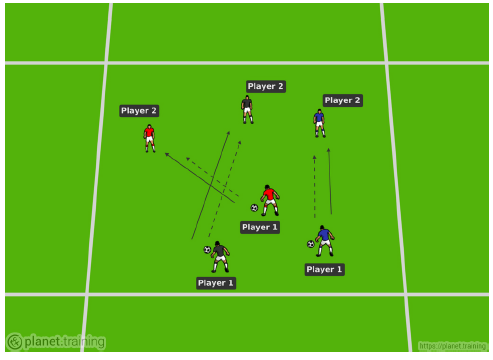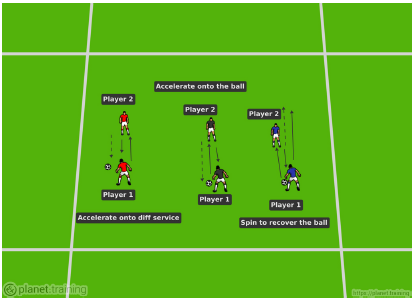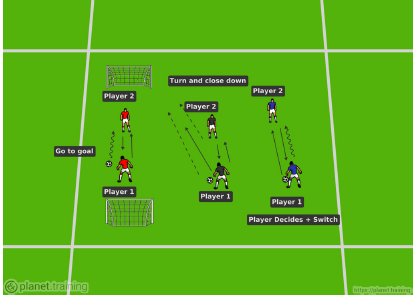By Sean Reed -
Objective
These sessions will focus on some individual movement work that can be carried out within the warm-up. They can also be linked in with any specific work you are focusing on within the session. They are there to provide some ideas, but like with every session can be developed and progressed.
Session 1

Diagram 1
Set Up
- Focusing on closing the player down, getting up to the ball and jockeying the player in possession (defending movements)
- The players are working in pairs with a ball between 2 within an area (the area can be altered depending on players). A good size area is recommended to provide space for players to run into
- Working in pairs, the players will work in between other pairs therefore working on their awareness as well as their movement
- If you have players that find the above challenging then you can have additional areas with less players in each.
- The players will move with the ball, Player 1 will look to play a pass when ready into Player 2 (ideally around 10yds)
- Player 1, once they have played the pass, they will then close Player 2 down and Player 2 will run at them with the ball for a few steps forcing Player 1 back to jockey the player in possession
- Player 2 will then carry the ball off into space and Player 1 will move off into another area.
- Player 2 will now play a pass to Player 1 and continue as outlined above)
Variations
- As above but after Player 1 (In possession of the ball) has been dribbling at Player 2 (Defending) they will then look to play a pass in behind Player 1 (Defending) to encourage them to turn and make a recovery run. Player 2 will then collect the ball and return the ball to Player 1. The roles are then switched as above. An example can be seen with Diagram 2
- Working over a shorter distance Player 1 plays a pass into Player 2. Player 1 will then close Player 2 down very quickly to force them to take a touch off line, away from the player closing them down (defending).
Coaching Points
- Acceleration after playing a pass to close the ball down
- Deceleration on approach – maintain good distance
- Side on body shape prepared for 2nd movement
- Balanced and weight on the back foot
- Movement backwards (side on, feet move together maintaining distance between feet) Avoid knocking ankles
- First step on transition (short)
Session 2

Diagram 2
[wpsharely id="1204"][/wpsharely]
Set Up
- Focusing on reactions, acceleration, short steps and transitional movements
- As above players remain in pairs within the area
- Initially start approx 5yds apart. Passing the ball between each other. After approx 4-5 passes, Player 1 leads and decides when and where to play a pass for Player 2 to react and collect the ball
- For example in Diagram 2 (Spin to recover the ball), Player 1 might play a pass behind Player 2 either side and Player 2 will quickly turn to recover the ball.
- The player (leading) playing the pass can also look to play the ball to the side or behind themselves, which will encourage the player working to react and move either to the side or forward
- The players can either work for a set number or switch roles after each go
- The next example in Diagram 2 (Accelerate onto the ball). The 2 players are passing the ball between each other and Player 1 leads and when ready with stop the ball dead, then move out of the way. Player 2 then has to react quickly running onto the ball, taking a touch and quickly turnning back.
- As above players can work for a set number or switch roles after each go
- The next example in Diagram 2 (Accelerate onto Diff Service). As with the previous example but the player leading can now play the ball in the air, bounce etc to encourage the player working to react and adapt to a different type of ball being received.
Coaching Points
- As within the previous session
- Focusing on the next phase
- Deceleration phase to turn
- Reducing the time between seeing and doing
- Turn leading with the correct foot, shortest distance when turning
- First movement and first step
- Adjusting step when receiving different types of service
- Managing 1st touch
Session 3

Diagram 3
Set Up
- Progressions from session 2
- In Diagram 3 (Player decides + switch) Player 1 and Player 2 are passing the ball between each other. Player 1 is leading and at any given time will start to dribble the ball toward Player 2 who will then starting working backwards (jockeying). After this, at anytime Player 1 can put their foot on the ball. That is a cue for Player 2 to stop jockeying and run forward onto the ball and dribble toward Player 1. Player 1 will the work backwards (jockeying). This continues for a period of time or a set number of times. Players switching roles and reacting quickly to get into the ball and also recover backwards. There is a mindset switch from attacking to defending and vice versa.
- In the next example in Diagram 3 (Turn and close down). The players will pass the ball between each other, Player 1 is leading, and at anytime will play a pass in behind Player 2 who turns to recover the ball, instead of standing and watching Player 1 will then close Player 2 down trying to prevent them from turning with the ball
- The next example in Diagram 3 (Go to goal). The players will pass the ball between each other. Player 1 will lead and at anytime Player 1 can start run with the ball at Player 2. They are looking to score in the small goal. If Player 2 wins the ball they have the chance to score in the goal that they are attacking. If no goals are available then you can use a line or an area for the players to run the ball into
Coaching Points
- As with the previous sessions
- Switching their focus on the next phase, within the transition period. From attack to defense and vice versa
By Sean Reed
Former First Team Coach of Championship side Fulham FC. Sean is a UEFA A Coach with a Masters in Sport Coaching. He has over 15 years of experience working in professional football from Academy through to First team in the Premiership and Championship.
Linkedin - www.developmentofplayers.com
Twitter - @SeanJReed


